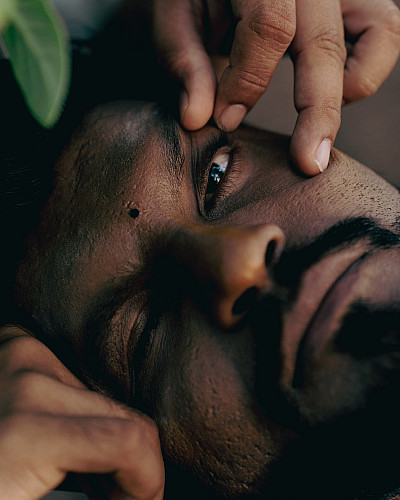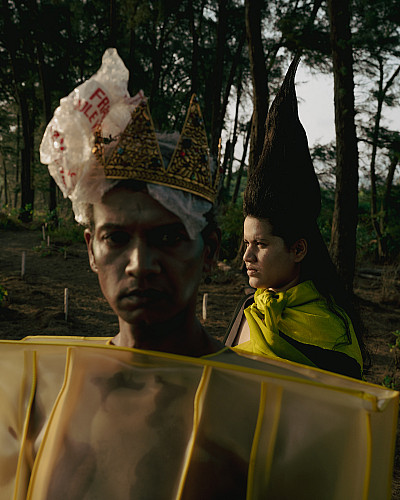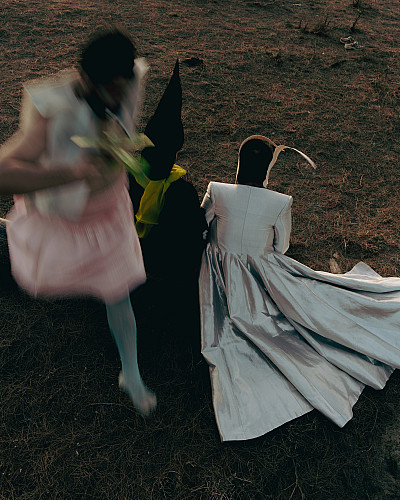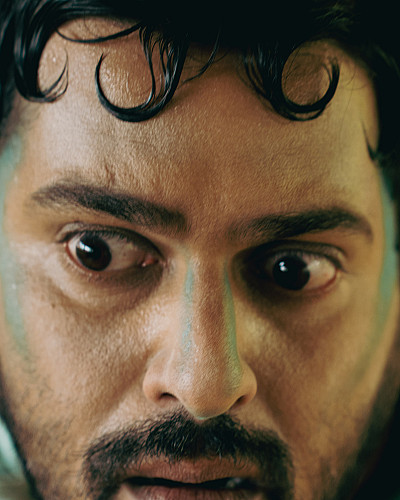Screen + Sound + Stage
Text by Ranjabati Das. Photography by Ali Monis Naqvi. Art Direction and Styling by Akanksha Pandey. Hair and Make-Up by Seerath Sheikh Kabir; assisted by Dixita Dhargalkar.
1. On Vibhav Sawant (Oberon): net dress and ball, from Savio Jon.
2. On Shreya Mukund Prabhu (Hermia): dome body dress, from Quod; bandhni scarf, from Savio Jon.
3. On Prajakta Kavlekar (Titania): top with box pleats, from Fool Dost; front-zipped black skirt, from Margn; red handloom scarf (tucked into the skirt), from Sirohi; green yoga gear (used as sash), stylist’s own.
4. On Keatan Jadhav (Demitrius): front knot shirt, from WIP Clothing; carved wooden face, from Savio Jon.
5. Mandar Jog (Puck)
6. On Shiv Pranav Damodar Alavani (Nick Bottom): jacket made out of recycled textile, from Dyelog; striped deconstructed pants with belt, from Savio Jon.
When Keatan Jadhav co-founded Theatre Flamingo (TF) in 2017 — not long after he completed his master’s in theatre from the Centre for Performing Arts at Savitribai Phule Pune University (popularly known as Lalit Kala Kendra) — it was with the express motive of expanding the space for theatre in Goa and cultivating it from the ground up. The troupe took flight with 10 graduates of the institution banding together, to create an intimate theatre experience that, for the most part, remains directed at those who are located outside urban narratives. A sense of purpose powers their passion for theatre, both verbal and non-verbal, and at its heart lies the motivation to educate and strengthen local communities, particularly younger members. “Grassroots theatre is difficult as the financial returns are uncertain. We need to work out the finances as the idea of theatre for people is important in today’s times,” notes actor Mandar Jog.
Like the large pink migratory bird it is named after, Theatre Flamingo has a penchant for travel, seeing that it opened its act as an itinerant theatre group. The very first initiative entailed performing for remote communities in the interiors of Maharashtra on a pay-as-you-like basis, where their main objective was to effect change and create social impact. After covering 4,700 kilometres in 17 days, they chose to move base to Canacona, instead of more lucrative cities like Mumbai and Delhi, where theatre has a ready audience. In Goa, where most hail from, they strive to empower marginalised groups situated across the state. Intermittently, they also cross over to cities like Mumbai, Pune and Bengaluru in neighbouring states with their art.
Their Konkani- and Marathi-language play Hattamalachya Palyad, adapted from playwright, director and actor Badal Sircar’s Hattamalar Oparey (Beyond The Land Of Hattamala), reflects this anti-capitalist belief system. Rooted in his Marxist ideologies, Sircar sought to bring the audience face to face with an egalitarian utopia of a world where money has no currency. This fictitious land lies in contrast to the capitalistic land of Hattamala where, much like the world we inhabit, the inclination towards consumerism is all-consuming.
Between rehearsals for Mukbhat, their adaptation of Shakespeare’s Macbeth, Verve talks to three members about their brand of experimental theatre, their commitment to their chosen medium of expression and how they navigate caste, religion and cultural norms when adapting plays to local contexts.
Excerpts from the conversations…
Handloom cotton pants, from Wunderhaus.
Keatan Jadhav, 30
Hometown: Canacona
Co-founder, Artistic Director and Actor
What does your role at Theatre Flamingo encompass?
I act, write, direct and work as administration head. I also act as a parent for the team members from time to time.
Where do you get your funding from?
We organise the annual Canacona Theatre Festival, which promotes regional and contemporary theatre and happens every May in Poinguinim village in commemoration of Badal Sircar’s death anniversary. For this, we have secured funding from people around the village in Canacona taluka. They help us not only monetarily but also by donating rice, oil, coconut, etc. It is open to all and this year, it showcased a diverse range of storytelling styles, ranging from Marathi dastangoi and musical satires to the Rajasthani kavad art.
1. Left to right — On Mandar Jog: cube rubber jacket, from Bloni; peplum skirt, from Rajesh Pratap Singh, blue stockings, stylist’s own. On Keatan Jadhav: crochet kimono jacket, from Bloni; panelled trousers, from Margn.
How did you capture the essence of Demetrius for the shoot?
Demetrius exhibits a fickle nature. His annoyance with Helena illustrates his unique characteristics; before being charmed in Act II, he even threatens her with bodily harm. And in the beginning of the play, his attention moves from Helena to Hermia quite swiftly. Demetrius represents the delicate balance between love and hate. I wanted to emphasise the contrast between these emotions to highlight his unpredictable nature.
Portraying his behavioural patterns through poses was new for me. I focused on physicality and body language. I made use of the latter to reflect the changing emotions and attitudes of Demetrius. I show that he is in love by using an open and inviting posture, and with gestures that convey warmth and affection. I adopt closed-off body language, such as crossed arms and defensive postures, to convey that he has fallen out of love.
Clockwise from left — On Prajakta Kavlekar: handmade organza flower and corded dress, from Vaishali S. On Keatan Jadhav: hand-painted shirt and pants in natural tones, both from Asaii. On Shreya Mukund Prabhu: silk top, from Rajesh Pratap Singh; organza skirt, from Vaishali S. On Vibhav Sawant: jumpsuit, from Rajesh Pratap Singh; headgear, from Valliyan. On Shiv Pranav Damodar Alavani: silver brocade jacket, from Rajesh Pratap Singh; handwoven tussar boxer shorts, from Fool Dost.
Why did Flamingo opt to stage A Midsummer Night’s Dream? The cast members are in character for the shoot...
A Midsummer Night’s Dream is a comedy that explores thwarted love, love that is abandoned, love that is redeemed, and more. We are currently prepping for it and it will be staged in 2024-’25. I can relate to it because of its universality. The play delves into the complexities of relationships and demonstrates the transformative power of love, which can be a source of joy and fulfilment.
However, it can also bring confusion, heartbreak and unexpected twists. A Midsummer Night’s Dream captures these aspects of love through its comedic lens, providing a relatable portrayal of the ups and downs in romantic relationships. The themes of forgiveness and personal growth can offer hope and inspiration. One can find solace in the fact that the complexities of love are a shared human experience.
How does Goa play into the kind of work that Flamingo does?
Unlike other cities like Mumbai and Pune, the residents of Goa do not have the tendency to pay for theatre other than perhaps Panjim or Margao. Tiatr — a form of musical theatre that is popular in the state and practised by the Catholic community — has its own audience.
But if you have to develop your forest land into cultivation fields for future generations, you have to start from scratch. Similarly, Theatre Flamingo looks to cultivate a space for theatre in Goa from the ground up.
Also, tell us about taking the more unconventional route of doing theatre in villages instead of moving to bigger cities that may offer better prospects.
“How can theatre feed you?” “How will you depend on it as a livelihood for a lifetime?” “Don’t gamble your life away doing theatre.” The taunts coming from my own family made me think, “Why am I studying theatre? What does it mean to us…our lives?” When I faced this question upfront, I thought I could find answers by building Theatre Flamingo…. It came from within. I thought, “Let’s go for it!”
Opportunities were sparse. But being a theatre artiste, I did not want to leave my medium and this was the trigger for launching our start-up.
From an early age, I was very motivated to spread the art of theatre in every nook and corner of the villages in Goa and I have been highly inspired by my guru, theatre artiste Vijaykumar Naik, who founded the Goa-based Hauns Sangeet Natya Mandal that’s been producing experimental theatre since 1950.
Is adapting a play to bring in the local context a tricky job — in cases where the play is from a different part of the country or the world? Can you tell us about some of the plays that have been adapted by your team?
I have adapted Shakespeare’s Macbeth in Konkani. Also, Molière’s Tartuffe in Hindi. Very often, the play has its own cultural references and when I work as a director on the scripts, I try to conceive and see the script through my own cultural lens. I feel theatre happens when there is a question and a character’s role on stage is to find the answers, whether it is a tragedy or comedy or any genre. Working on a play is also about performative research on the issues.
Practising theatre is about paying attention to other people. And this is the basis of the ethics here. Theatre is built on observing the actions of other human beings. This means putting yourself in others’ shoes. Exercising the ability to understand what it means to be someone else. And the more you exercise empathy, the less you can hurt others or disagree with someone’s opinion. Also, plays often reflect society. So, obstacles faced by the characters in any play have the power to appeal to the audience, irrespective of where and when that play has been written.
We have read that you’re on a quest to develop an acting approach using body, emotions and voice in your TF Actors Lab. And in this, you have incorporated the Butoh technique. Can you tell us more? What is the lab all about?
I employ theatre research and the intricacies of the craft of acting to offer practical advice to professional and aspiring actors alike. In my acting career, I am driven by a firm belief in rigorous training. You see engineers, doctors and scientists go through this kind of training usually — and, as a result, they also get the space and opportunity to perfect their techniques after their college education. In this acting approach, which I call the Scaffolding Method, the goal is to perfect one’s body to such a degree that it becomes capable of all requirements for the stage. So begins the journey to become an athlete of emotions that enables one to pursue any artistic tasks. We provide the overall training to our bodies, voices and imagination, through deep experimentation with oneself.
You developed the Ghumchye Kattar Theatre project in 2018, to encourage children to read. It is said to have reached 13,000 children. What drew you towards this endeavour?
My school did not have a library and so I did not get much access to books. But my teachers would scold me for not reading books. This shouldn’t be the way to handle the situation. So I designed a project called Ghumchye Kattar Theatre where, through theatre, we encourage children to develop an affinity towards reading books.
Stories, storytelling, enacting…they have the power to reach within us, command emotions, compel involvement. Stories provide us with practical insight into approaches we can take when it comes to our most persistent environmental difficulties. We planned activities around this idea; hence, this folk-based theatrical venture is called Ghumchye Kattar Theatre or “the storytelling journey”.
Ghumchye Kattar Theatre is a nine-month-long theatre programme directed at tribal areas. The theatre-based interactive stories encourage one to build listening skills and pushes ones towards teamwork and creative writing. Its objective is to help build confidence, raise self-esteem and develop imagination.
The choice of stories is driven by their ability to develop emotional literacy and increase children’s capacity for empathy. Using live and interactive theatre, we invite and inspire young people to think about their choices and the consequences of their actions on the environment in a humorous and engaging way.
You acted in the short film, A Cold Summer Night, which was officially selected for Locarno Film Festival, Busan International Film Festival, and a whopping 33 other national and international film festivals. It deals with the migrant issue in Goa. What are your thoughts on the surge of people moving to Goa in recent years?
Migration is a lifestyle and a major behaviour of our society or any society in the world. Most still can’t find a satisfactory space to live a sustainable life easily. But in this scenario, if you become an outsider or society makes you an outcast, it’s a problem and it’s painful. I have gone through this, as my father is a Maharashtrian. So I have felt judged and the energy I have felt at times is very unnatural.
1. Foreground — On Vibhav Sawant: rubber sculpted dress, from Bloni. Background — On Prajakta Kavlekar: black gown with elongated pink sleeve details, from Rajesh Pratap Singh; green shibori top (used as scarf), from Studio Medium.
2. On Mandar Jog: blue stockings, stylist’s own.
How has the audience changed in Goa over the years? How does the location impact you as an artiste?
Earlier, I wanted to showcase my work in Pune, Mumbai, etc. where I can get a theatre-going audience. But nowadays I want to do theatre in my hometown of Canacona and I gradually want to build my own audience. Sometimes, I feel apprehensive of the experimental theatre I practise at TF Actors Lab in Goa because we do not have an audience. But the scenario has been changing slowly. The audience has been welcoming of the new vocabulary of performance that they have witnessed of late.
Mukbhat is the latest Shakespearean play adapted by Theatre Flamingo….
We opened our adaptation of Shakespeare’s Macbeth in Ponda earlier this year. We have been working on Mukbhat since last year. It is an experimental play that uses modern theatrical tools and blends them with traditional practices to create a contemporary narrative that raises questions on gender politics, temple politics and caste hierarchies in Goan villages. The play shows how each character here is entrenched in caste, religion and cultural norms.
The play centres around Mukhel-Bhat and his wife Annapurna’s dehumanising behaviour towards their adopted son Mukbhat. Ultimately, it makes him kill his parents. Mukbhat invites the audience to experience the roots of stifled ambition, unfulfilled desire and ultimate loss. Now, we are looking for theatre festivals in and outside India.
Do you prefer verbal or non-verbal plays — since you have worked with both?
Initially, when I started out, I was motivated by scripts, but after a point, I started getting into non-verbal physical theatre, because language can’t say as much as our emotions and actions can.
Tell us about a favourite non-verbal Theatre Flamingo performance….
Moments In Movements is a performance by a bare body smeared with colours. The body presses, drags and lays the colours across canvases to create bodily impressions. This piece was performed in the pinewood jungle of Galgibaga, South Goa, in January 2022. The piece refers to the painting practices of Jackson Pollock, who would pour and drip paint onto his canvases. This performance takes spectators of the physical element of painting even further by adding an audience member and using the human body to spread the paint. In utilising the body as a breathing paintbrush, performer Amodi Sanap challenges viewers’ expectations about the cultural process of creating art. By incorporating the human body into the act of creating art, the performer will give the performativity of the body an unprecedented privilege within its discourse. This performance makes an association between nature, human skin, colour, canvas and literature. The performer uses the process of improvisation through which she focuses more on spontaneity, impulses and the feeling of the colours’ texture on the skin.
What’s next for Theatre Flamingo?
We aspire to have our own drama school and a repertoire company in Goa through which we can stage experimental plays, children’s theatre, toddler theatre, applied theatre, etc. We will continue our children’s theatre project from June to March. We will focus on travelling with our theatre group from March to May. And the Canacona Theatre Festival will take precedence in May.
Mandar Jog, 37
Hometown: Ponda
Actor
What stood out for you with regards to Puck, the character you will play on stage for Theatre Flamingo’s production of A Midsummer Night’s Dream?
Until this point, I had never tried my hands at comedy. Exploring a new character and, particularly, the mischievous nature of the character by correlating it to real-life examples was an interesting experience for me.
The pros and cons of being part of a travelling theatre group?
The pros would include the opportunity to travel and explore new places and spaces that enhance my experience as an actor as well as a human. Also, it helps me to understand and get in tune with my fellow team members which, in turn, affects us immensely on stage.
There aren’t any cons as such as of now for me. But, at times, the travel takes a toll on your body. And there are days that make you look away from the task at hand merely because of the uncertainty in our field, say, in terms of the audience turnout or the reception.
What are some of the strategies that the team has innovated together? What worked and what didn’t work over time?
We are constantly in the process of finding new strategies to reach our audience and build a consistent turnout for our performances, and it’s always a roller-coaster ride. Our latest practice of performing in cafes in Goa is picking up slowly. This interview is a result of one such performance — Jamun Ka Ped, The Jamun Tree at Saraya Cafe in Sangolda in North Goa — so I would say this strategy is helping us grow.
Do you think that A Midsummer Night’s Dream resonates with the younger generations?
The play has everything in it. It has themes of love and relationships, identity and gender, fantasy and escapism, youth and rebellion, humour and entertainment, and also theatricality and performance. And all these topics are evergreen topics. So for me, this play is an evergreen play that would work in all ages and contexts. It resonates with younger generations and will do the same with future generations as well.
Would you agree that while mainstream Indian films are looking at creating “pan-Indian” blockbusters in order to get a bigger piece of the pie, you are at the opposite end of the spectrum: taking and even introducing theatre to people in the remotest of villages?
While mainstream Indian films focus on reaching a wide audience to achieve commercial success, theatre groups like ours are trying to prioritise cultural outreach, social impact and community engagement. We aim to bring the transformative power of theatre to people in remote and often marginalised communities. Both approaches play significant roles in enriching cultural experiences and expressions in India.
Local contexts are often incorporated into the plays. Can you share an example of the same along with the core intent?
We reimagined A Midsummer Night’s Dream in a Goan context. I feel the incorporation of local culture in the play makes the content more relatable and entertaining.
What languages are your plays in?
In our plays, we speak in Marathi and Konkani, both of which are equally prevalent in Goa. The flavour of the language changes from Pernem to Canacona, thereby giving it a more intricate colour of the vicinity. We have also used Hindi and English. We, as actors, are never bound by language; if there is a need to incorporate a dialect of a specific locale we do make sure that we work on it.
Your take on grassroots theatre, theatre for the people?
It is difficult as the financial returns in the process are uncertain. We need to work out the finances as the idea of theatre for people is important in today’s times.
Prajakta Kavlekar, 28
Hometown: Ponda
Actor
What does your role at Theatre Flamingo encompass?
I am an actor and I have been one of the core members of the group since it was founded in 2017. I have designed costumes for all the plays except for the latest one, Mukbhat. I also help Keatan [Jadhav] with the management and marketing decisions.
According to you, why do Shakespearean plays work in the current times?
These are classic plays, and we still find them to be extremely relevant. The resemblances to real life are striking.
Tell us about how productions take shape at Theatre Flamingo?
Whoever wants to direct a play talks to everyone in the team about it. We have a discussion around why they want to do that particular play and how they are planning to execute the whole process, and then, according to everyone’s schedule, we start the process. It is not any one individual’s call — it is a very collaborative process.
Kala cotton patchwork jacket, from WIP Clothing.
What is your favourite Flamingo performance and why?
I have two! One is Dumb Indignation, a non-verbal solo performance directed by Keatan Jadhav and performed by Amodi Sanap. I’ve been part of this production since day one and every time I see this performance — it has been staged 47 times till now — I find the director and actor adding something new to the show. The second one is Hattamalachya Palyad, where I play 12 characters. Even after 40 shows, we still come up with new ideas during rehearsals.
You played a toddler, an old woman and sundry others in Hattamalachya Palyad, Theatre Flamingo’s adaptation of Badal Sircar’s anti-establishment play Hattamalar Opare (Beyond the Land of Hattamala)….
I like experimenting with characters and this is why I took on Hattamalachya as a challenge. I feel I am very good at portraying realistic characters. However, the characters in Hattamalachya are a bit of a caricature. It was also difficult for me as I had to play 12 characters. There was no make-up and not much difference in costume — say, just a sash or a single element that changed with the characters. I had to find 12 different walks and voices — ranging from a young boy to a 60-year-old grandmother. There were a lot of factors that I had to keep in mind. For example, this play is happening in a land where there is no concept of money — how will people decide what is happiness and what is work, and what do they expect in return if there is no money.
I wasn’t sure how it would turn out until the first show. I can’t take all the credit for developing these different characters — my co-actors are equally deserving of praise for building some of these. For this one, we also collaborated with 25-year-old Marathi writer-translator-actor, Aniruddha Deodhar, one of our juniors at Lalit Kala Kendra in Pune. He translated the Bengali play into Marathi for us.
You work in serials as well as experimental theatre — the two seem poles apart.
They serve different purposes for me. One is just a source of income while the other reflects my deep love and passion towards art and creativity. I was part of the performing arts faculty in a college at Ponda but have recently shifted to Mumbai to work as a costume designer and casting director. I did a few serials last year while I was doing Hattamalachya — like the Marathi Raja Rani Chi Ga Jodi and Sukh Mhanje Nakki Kay Asta. The plan is to get cast in a film or a web series in order to earn some money before I go back to my state and troupe.

















